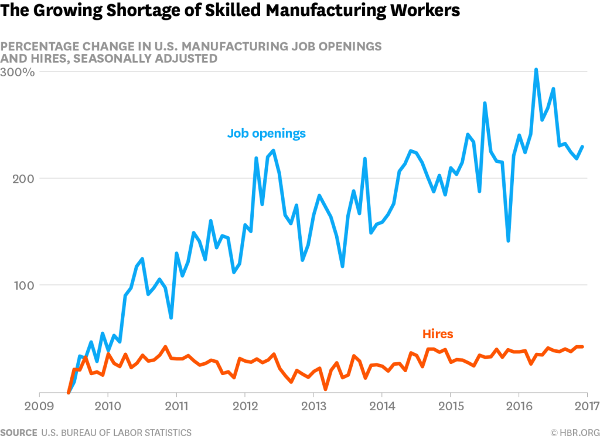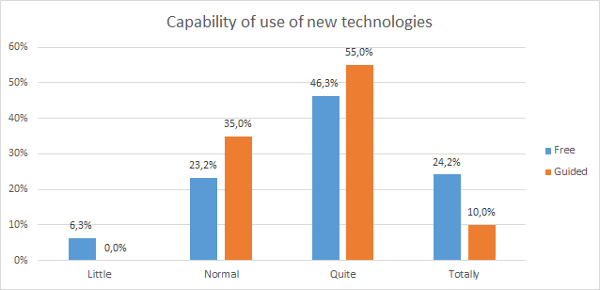One of the downturns of the global population ageing is that the elders work longer, making the natural turnover at the workplace slower.
The ageing workforce doesn’t translate just in demographic problems, but also in knowledge transfer problems to the youngest generations.
Because the younger generations have less chances to start their career and build their skill set, the result is a big experience gap between old and young workers.

This is where technology comes into play. Since providing an effective and comprehensive training requires a certain amount of hours spent in class and in the field, technologies like Augmented Reality can be a useful training tool for at least two reasons: 1) it is more practical; 2) the information is longer retained.
An important scenario where AR Training is extremely relevant is in safety applications. In 2014, there were close to 3.2 million non-fatal accidents that resulted in at least four calendar days of absence from work and 3.739 fatal accidents in the EU-28 (ESAW).
A case study for safety applications
The European project Angels (Augmented Reality Network Generating Learning on Safety) was carried out between 2013 and 2014 by a team made of Policlinico Tor Vergata (Italy), Hopital Brocà (France), NCONZO (Cech Republic), UJI (Spain), Entropy KN (Italy) and Inglobe Technologies (Italy) with the aim of assessing the impact of AR in training for prevention of risks in the workplace in the healthcare sector.
The hospitals involved were:
- Hôpitaux de Paris (France)
- University Hospital Brno (Czech Republic)
- Hospital Virgen de los Lirios; Hospital Nisa Rey Don Jaime; DIAVERUM center (Spain)
- Policlinico Tor Vergata (Italy)
The main objective of the project was to compare the learning performance and ease of use of AR training with respect to traditional training on books and in the classroom.
How the AR Training was carried out
The method of assessment was a large scale trial, involving 117 participants from four countries with the following work roles: nurses; auxiliary nurses; nursing students; doctors; and other healthcare professionals (e.g. psychologists). The average age of seniority in the role was 8,76 years.
The training duration was 15 days, during this period the participants had the chance to use the system in one of the two available modes: free and guided.
Using the system in free mode the trainee is free to explore the environment retrieving information about generic risks.
Using the system in guided mode the trainee has to follow a series of obliged steps related to specific risks.
82% of the participants used the system in free mode, the remaining 18% used it in guided mode.

Before and after the training period, the participants filled in pre-assessment and post-assessment tests aimed at understanding their level of comfort with new technologies as well as the learning impact of using the ANGELS system.
Based on the information provided by the participants, by means of the assessment tests, results were prepared and summarized in the following paragraphs.
The ANGELS AR Platform for Safety
The Angels system used for the training activities is an authoring platform developed by Inglobe Technologies composed by a web-based software, a server and a mobile client.
The web-based platform enables the creation of custom Augmented Reality procedures for safety purposes, allowing the administrator to upload a planimetry related to the building where the safety risks have to be managed. The administrator can manually place the safety procedures in specific areas/rooms on the planimetry, so that when the user is in a given area of the building, by scanning the nearest QR Code, she can visualize what are the safety risks in the area and she can access the procedures on how to manage those risks.
Joint Analysis Results
The results of the study include an analysis of several variables like the participants’ capability of use of new technology, preference towards the traditional or the AR system, overall performance of participants trained with the traditional system compared to those trained with the AR system.

Regarding the familiarity with new technologies it is clear that the participants didn’t have a high technological aptitude, they were average users. It is not necessary to be a power user in order to be able to use AR systems effectively.

When faced with the decision of which system they prefer to use to carry out training activities, about three fourths of the participants declared they prefer the ANGELS AR system over the traditional one.

Finally, the results from the post-assessment questionnaire clearly showed how the ANGELS system was able to improve the level of knowledge of trainees about the risks in the hospitals. In general the guided training mode proved to be slightly at increasing the level of knowledge.
Conclusions
The evidence from the ANGELS project, clearly proves that Augmented Reality is a very effective technology used in the context of training activities.
Moreover no particular technological aptitude is required to trainees, in fact the average trainee can easily use AR training system with success and improve her knowledge.
References:
Platform Home Page: http://projects.armedia.it/projects/angelsSK/
Project Preliminary Paper: http://www.inglobetechnologies.com/wp-content/uploads/2014/06/paper_ICERI2013_Angels.pdf
